 W
WRepresentations of slavery in European art date back to ancient times. They show slaves of varied ethnicity, white as well as black.
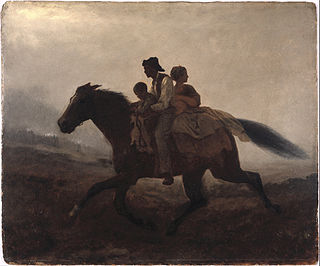 W
WA Ride for Liberty – The Fugitive Slaves (1862) is a painting by the American artist Eastman Johnson that depicts a family of African-Americans fleeing enslavement in the Southern United States during the American Civil War. It is based on an event that Johnson claimed to have witnessed near Manassas, Virginia, on March 2, 1862.
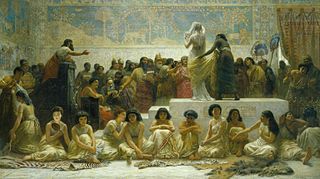 W
WThe Babylonian Marriage Market is an 1875 painting by the British painter Edwin Long of young women being auctioned into marriage. It received attention for its provocative depiction of women being sold and its attention to historical detail.
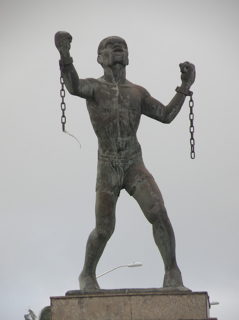 W
WThe Emancipation Statue is a public sculpture symbolising the "breaking of the chains" of slavery at Emancipation. It is located in Barbados, east of Bridgetown at centre of the J.T.C. Ramsay roundabout formed at the junction of the ABC Highway and Highway 5. Many Barbadians refer to the statue as Bussa, the name of a slave who helped inspire a revolt against slavery in Barbados in 1816, though the statue is not actually sculpted to be Bussa.
 W
WThe Captive Slave is a portrait painted by the artist John Simpson (1782–1847), which was first exhibited in London in 1827. It shows a man, manacled, on a stone bench and looking pensively or plaintively upward. Its subject matter, historical period, and mode of creation suggest the artist intended the painting as a statement against slavery. Until acquired by the Art Institute of Chicago in 2008, it had not been displayed to the public for 180 years.
 W
WWhy Born Enslaved! or Why Born a Slave? is a life-sized marble bust by the French sculptor Jean-Baptiste Carpeaux depicting a bound woman of African descent.
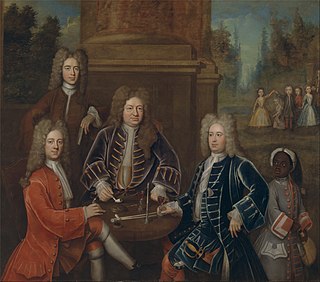 W
WElihu Yale seated at table with the Second Duke of Devonshire and Lord James Cavendish is a group portrait of Elihu Yale with William Cavendish and his brother James in England. It is currently in the collection of the Yale Center for British Art.
 W
WThe Emancipation Memorial, also known as the Freedman's Memorial or the Emancipation Group is a monument in Lincoln Park in the Capitol Hill neighborhood of Washington, D.C. It was sometimes referred to as the "Lincoln Memorial" before the more prominent so-named memorial was dedicated in 1922.
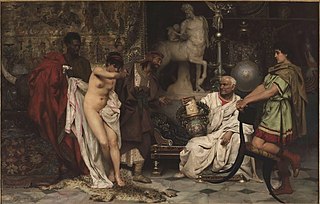 W
WThe Girl or the Vase, also known as The Presentation of the Slave, is an 1878 painting by the Polish artist Henryk Siemiradzki. The subject is from ancient Rome and shows a patrician who contemplates on whether he should buy an East Asian vase or a slave girl. The painting earned Siemiradzki the gold medal at the 1878 World's Fair in Paris and the French Legion of Honour.
 W
WThe Hunted Slaves is a mid 19th century painting by British artist Richard Ansdell. Done in oil on canvas, the work depicts two African American slaves facing down a group of hunting dogs as the two slaves flee. The work is in the collection of the International Slavery Museum in Liverpool.
 W
WThe Portrait of Juan de Pareja is a painting by Spanish artist Diego Velázquez of his assistant Juan de Pareja, a notable painter in his own right, who was enslaved and owned by Velázquez at the time the painting was completed. Velázquez painted the portrait in Rome, while traveling in Italy, in 1650. It is the earliest known portrait of a Spanish man of African descent.
 W
WThe Kitchen Maid is one of two paired domestic paintings by Diego Rodríguez de Silva y Velázquez from his early Seville period. A wide range of dates has been suggested for its completion, although most place it between 1620 and 1622. This version is kept in the Art Institute of Chicago. The second version is held at the National Gallery of Ireland.
 W
WLe Marron Inconnu de Port au prince, shortened as Le Marron Inconnu, also called Le Nègre Marron or Nèg Mawon, is a bronze statue of a runaway slave; better known as a maroon, standing in the center of Port-au-Prince, Haiti. Completed on September 22 1967 by Haitian architect Albert Mangonès, the statue is regarded as a symbol of black liberation; commemorating in particular, the rallying cry that sparked the Haitian Revolution and the abolishment of slavery. Situated across from the National Palace, it is the nation's most iconic representation of the struggle for freedom.
 W
WThe Miracle of the Slave is a painting by the Italian Renaissance artist Jacopo Tintoretto, and is now in the Gallerie dell'Accademia in Venice. It was originally commissioned for the Scuola Grande di San Marco, a confraternity in the city.
 W
WNegro Life at the South (1859) is a painting by American artist Eastman Johnson that depicts the private life of African-American slaves in Washington, DC. It was painted in Washington, D.C. and is now owned by the New York Public Library, on permanent loan to the New-York Historical Society. Johnson also created two versions of the painting in the 1870s, now owned by the High Museum of Art in Atlanta.
 W
WProclamation of the Abolition of Slavery in the French Colonies, 27 April 1848 is an 1849 painting by French artist François-Auguste Biard which is kept in the Palace of Versailles, France.
 W
WThe Rebellious Slave is a 2.15m high marble statue by Michelangelo, dated to 1513. It is now held in the Louvre in Paris.
 W
WThe Red Sea Sharks is the nineteenth volume of The Adventures of Tintin, the comic series by Belgian cartoonist Hergé. The story was initially serialised weekly in Belgium's Tintin magazine from October 1956 to January 1958 before being published in a collected volume by Casterman in 1958. The narrative follows the young reporter Tintin, his dog Snowy, and his friend Captain Haddock as they travel to the fictional Middle Eastern kingdom of Khemed with the intention of aiding the Emir Ben Kalish Ezab in regaining control after a coup d'état by his enemies, who are financed by slave traders led by Tintin's old nemesis Rastapopoulos.
 W
WThe Runaway Slave is a sculpture in gypsum-tinted bronze by Vladimir Aleksandrovich Beklemishev, produced in Italy in 1891.
 W
WSlave Market in Ancient Rome is a painting of about 1884 by French artist Jean-Léon Gérôme, who was known for combining classical, romantic, and realistic elements. It depicts an Ancient Roman slave auction in progress. At the center of a high dais is a completely nude women having been recently undressed by the slave dealer situated to her right, who is displaying her to the crowd as they bid on her. The woman shields her eyes with her right hand due to the humiliating predicament of being publicly exposed in front of such a large crowd. Another nude young woman is sits fearfully at the first woman's feet, covering her breasts with her legs in a protective pose, however, this leaves her genitals exposed to the crowd. Behind her is an older clothed woman holding an infant, she is surrounded by two naked children who she is probably the mother of. Her face has a look of dread as she knows she is to be auctioned soon, most likely being separated from her children forever. Behind the auction booth, two men are keeping an account of the sales, with a row of enslaved men looking on from behind them. It is one of his six slave-market scenes set in either ancient Rome or 19th-century Istanbul that Gérôme painted during his career.
 W
WThe Slave Market is a painting first exhibited at the Paris Salon of 1886 by the French artist Gustave Boulanger, who specialized in classical and Orientalist genre scenes. Its title in the Salon catalogue was Un Maquignon d’esclaves à Rome, but as early as 1888 it was called Vente d’escalves in the French press, and in English it has become known as The Slave Market. It is sometimes compared to or confused with various paintings of slave markets in the Arab world and the ancient world by Boulanger's friend and fellow painter Jean-Léon Gérôme.
 W
WThe Slave Market is an 1866 painting by the French artist Jean-Léon Gérôme. It depicts an unspecific Middle Eastern or North African setting where a man inspects the teeth of a nude, female slave.
 W
WSlave Play is a three-act play by Jeremy O. Harris. The play is about race, sex, power relations, trauma, and interracial relationships. It follows three interracial couples undergoing "Antebellum Sexual Performance Therapy" because the black partners no longer feel sexual attraction to their white partners. The title refers both to the history of slavery in the United States and to sexual slavery role-play.
 W
WThe Slave Ship, originally titled Slavers Throwing overboard the Dead and Dying—Typhon coming on, is a painting by the British artist J. M. W. Turner, first exhibited at The Royal Academy of Arts in 1840.
 W
WThe Statue of Liberty is a colossal neoclassical sculpture on Liberty Island in New York Harbor within New York City, in the United States. The copper statue, a gift from the people of France to the people of the United States, was designed by French sculptor Frédéric Auguste Bartholdi and its metal framework was built by Gustave Eiffel. The statue was dedicated on October 28, 1886.
 W
WUncle Tom and Little Eva is an oil on canvas painted by Edwin Longsden Long in 1866. It depicts a scene from the novel Uncle Tom's Cabin. The painting is kept at Russell-Cotes Art Gallery & Museum.
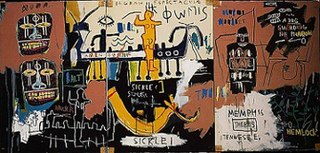 W
WUntitled , also known as The Nile, is a painting created by American artist Jean-Michel Basquiat (1960–1988) in 1983. The artwork references Ancient Egypt and Southern United States culture to critique the Western society's understanding of history and its forgetfulness towards slavery.
 W
WThe Verdict of the People is an 1854 painting by George Caleb Bingham, currently owned by the Saint Louis Art Museum.
 W
WVerigar was the first postage stamp series of the State of Slovenes, Croats and Serbs, issued in Slovenia after the dissolution of the Austro-Hungarian monarchy at the end of World War I. The name of the stamp series is derived from the Slovene word veriga, meaning 'chain', and depicts a slave who has broken the chains. The scene symbolizes the freedom of the Slavic peoples from Austria-Hungary. It was designed by the academic painter Ivan Vavpotič, whose model was the gymnast Stane Derganc.
 W
WThe Young Slave is a marble sculpture of Michelangelo, datable to around 1525–1530 which is conserved in the Galleria dell'Accademia in Florence. It is part of the "unfinished" series of Prigioni intended for the Tomb of Julius II.
 W
WZaide is an unfinished German-language opera, K. 344, written by Wolfgang Amadeus Mozart in 1780. Emperor Joseph II, in 1778, was in the process of setting up an opera company for the purpose of performing German opera. One condition required of the composer to join this company was that he should write a comic opera. At Salzburg in 1779 Mozart began work on a new opera. It contains spoken dialogue, which also classifies it as a Singspiel. Only the arias and ensembles from the first two acts were composed. Missing are an overture and third act.
 W
W